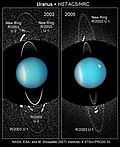Rings of Uranus
The rings of Uranus are planetary rings (circles of rock and dust) around the planet Uranus. There are 13 rings in total.[1] In order of increasing distance from Uranus, they are: 1986U2R/ζ, 6, 5, 4, α, β, η, γ, δ, λ, ε, ν and μ.[2]
Nine rings were found on 10 March 1977 by James L. Elliot, Edward W. Dunham and Douglas J. Mink. Scientists found two more rings in 1986 in images from the Voyager 2 spacecraft and two outer rings in 2003–2005 in images from the Hubble Space Telescope.
Most of the rings are only a few kilometres wide and are very dark. Most rings are made of rocks 0.2–20 meters wide. But some rings are made of very small dust particles. The closest ring is 38,000 km away from the center of Uranus and the furthest ring is 98,000 km away.
Scientists think that the rings are at not more than 600 million years old. The ring system was created when several moons crashed together. After crashing, the moons broke up into many pieces and made rings. People may discover more rings in the future.
Rings Of Uranus Media
Comparison of the Uranian rings in forward-scattered and back-scattered light (images obtained by Voyager 2 in 1986)
A long-exposure, high phase angle (172.5°) Voyager 2 image of Uranus's inner rings. In forward-scattered light, dust bands not visible in other images can be seen, as well as the recognized rings.
The discovery image of the 1986U2R ring
The μ and ν rings of Uranus (R/2003 U1 and U2) in Hubble Space Telescope images from 2005
An enhanced-color schematic of the inner rings derived from Voyager 2 images
References
- ↑ Esposito, Larry W., ed. (2014), "Uranus' rings and moons", Planetary Rings: A Post-Equinox View, Cambridge Planetary Science, Cambridge: Cambridge University Press, pp. 151–154, ISBN 978-1-139-23696-6, retrieved 2025-03-20
- ↑ "Uranus: Facts - NASA Science". 2017-11-10. Retrieved 2025-03-20.








